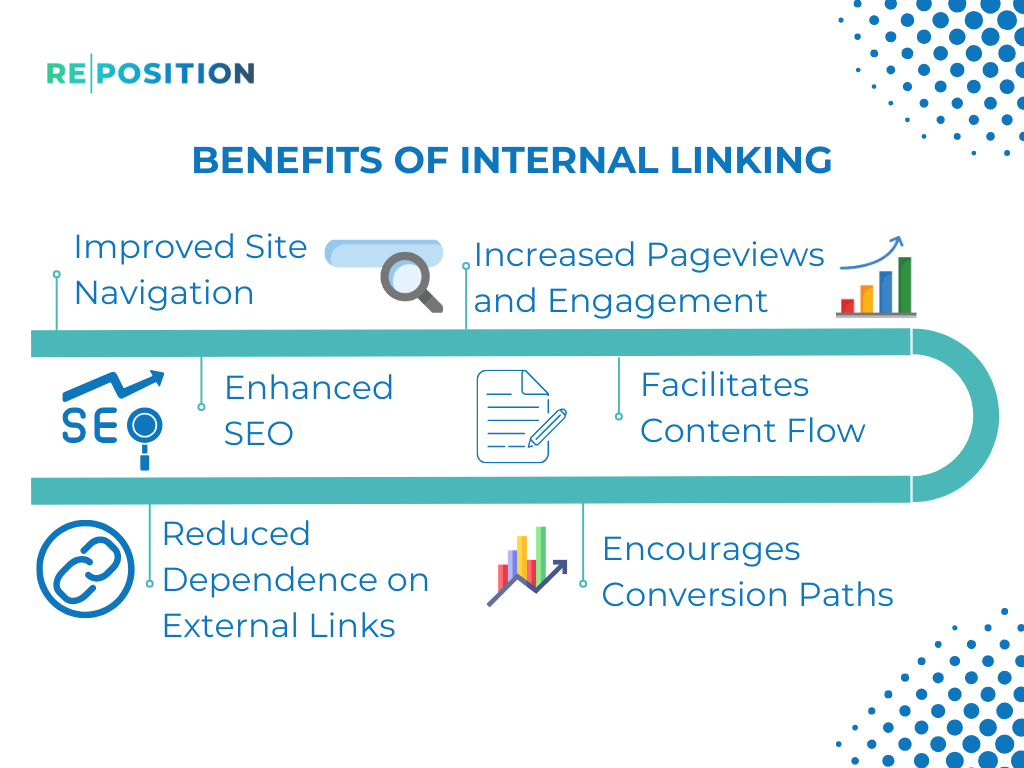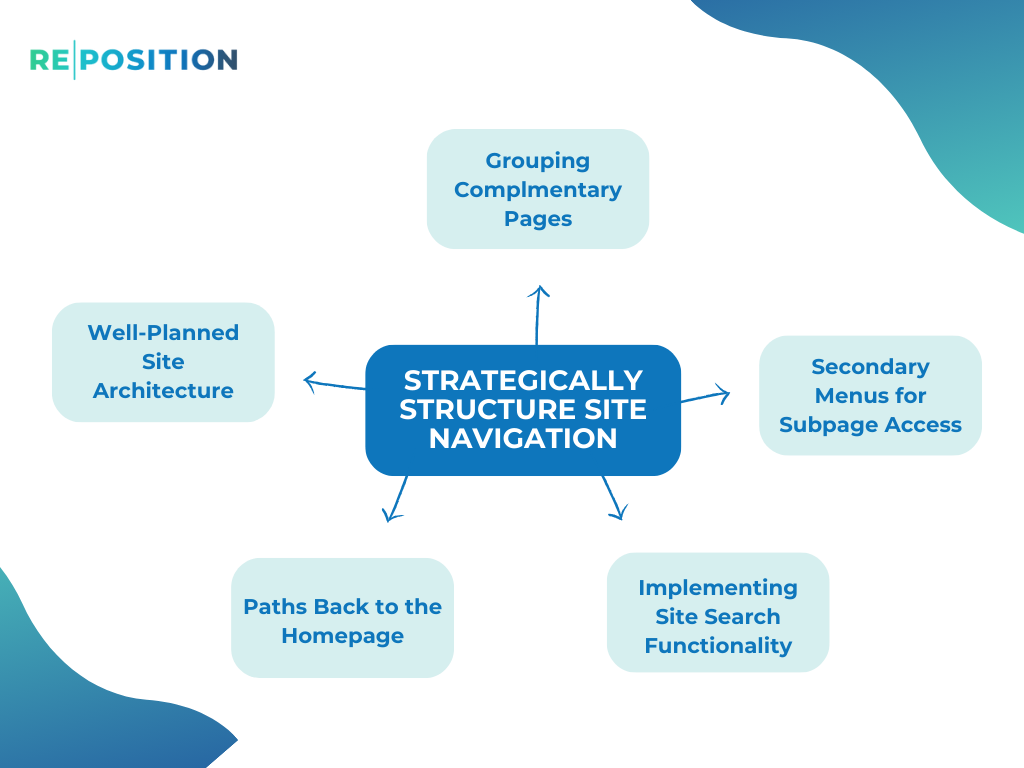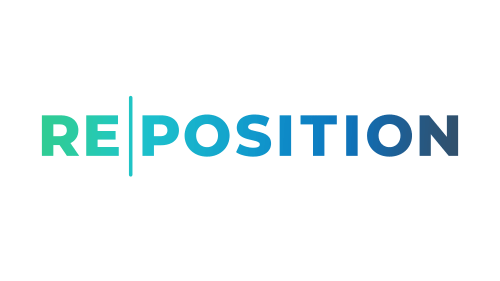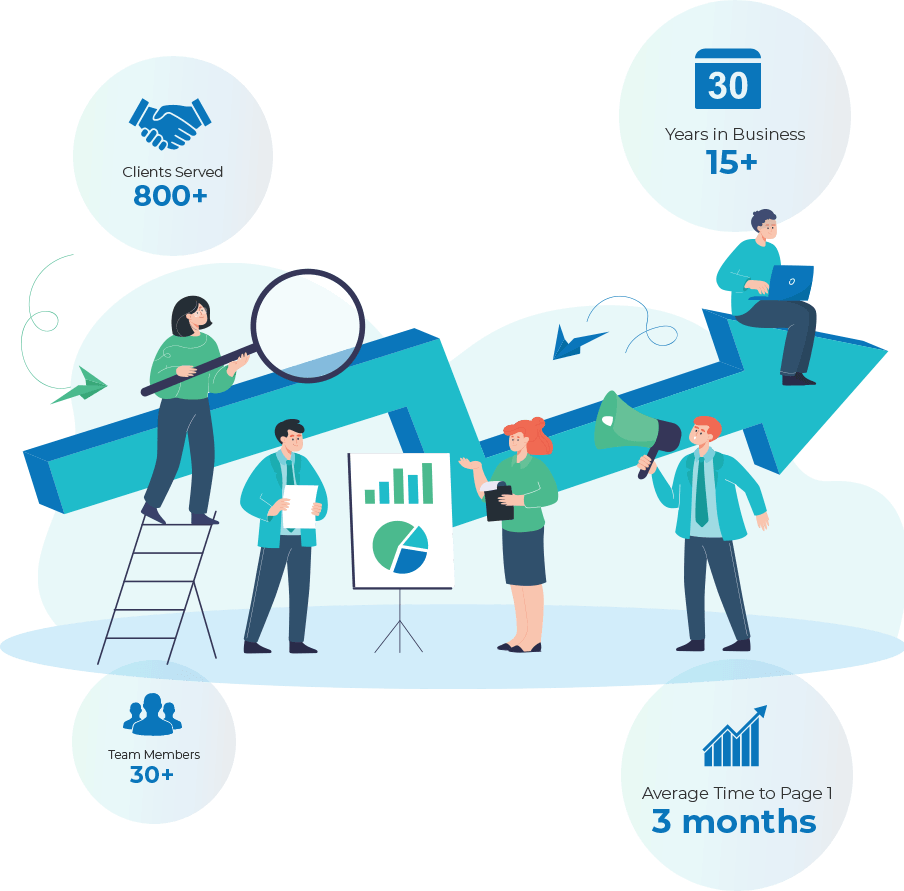Internal Linking
Internal links are hyperlinks that connect different pages within the same website or blog. Implementing a well-planned internal linking structure is crucial for achieving higher rankings in search engines and enhancing the overall user experience. Unlike external links from other sites, internal links allow webmasters to have better control over link flows and the distribution of equity across various pages.
Some Key Benefits Of Internal Linking Include
Internal linking offers a range of key benefits that contribute to the overall success of a website. Here are some of these advantages.

Improved Site Navigation
Enhanced User Experience – Strategic internal linking helps in creating a well-organized and structured website. Users can navigate seamlessly between related content, making it easier for them to find relevant information.
Reduced Bounce Rates – By providing clear pathways between pages, internal links reduce the likelihood of visitors bouncing off your site. This improved navigation encourages users to explore more of your content.
Increased Pageviews and Engagement
Higher Click-Through Rates (CTR) – Pages that receive more internal links often experience higher click-through rates. When users encounter relevant links within the content, they are more likely to click and explore additional pages.
Extended Visit Time – Internal linking contributes to increased time spent on the website. Visitors are more likely to engage with multiple pages, leading to extended dwell time, which is a positive signal for search engines.
Enhanced SEO
Contextual Relevance – Contextual internal links establish a thematic connection between different pages on your site. This not only aids users in understanding the relationship between topics but also signals to search engines that your content is interconnected and relevant.
Passing Authority – Internal links can distribute authority and link equity across your website. When high-authority pages link to others, they pass on some of their authority, potentially boosting the rankings of linked pages in search engine results.
Improved Crawling and Indexing – Search engine crawlers use internal links to discover and index content on your site. Effective internal linking ensures that all pages are easily accessible to search engines, contributing to a more comprehensive and well-indexed website.
Facilitates Content Flow
Guiding User Journeys – Internal links can guide users through a logical flow of content, leading them from introductory articles to more in-depth resources. This helps in shaping user journeys and directing them towards valuable information.
Showcasing Related Content – By linking related articles or products, you can showcase additional content that users might find interesting or helpful, encouraging them to explore more areas of your site.
Reduced Dependence on External Links
Self-Referencing Authority – Internal linking allows your website to establish its authority without solely relying on external backlinks. While external links are crucial, a well-structured internal linking strategy reinforces your site’s credibility and expertise.
Encourages Conversion Paths
Strategic Linking to Conversion Pages – Internal links can be used to guide users towards conversion-focused pages, such as product pages, contact forms, or subscription pages. This strategic linking helps in channeling traffic towards key areas that contribute to your business goals.
The benefits of internal linking extend beyond mere navigation improvements. They play a vital role in enhancing user experience, engaging visitors, and strengthening the overall SEO profile of a website. A thoughtful and strategic internal linking strategy contributes to the holistic success of your online presence.
Conduct A Website Content Audit
Conducting a website content audit is a crucial step in optimizing your internal link strategy. This process involves a comprehensive review of your site’s architecture and content, providing valuable insights that can shape a more effective internal linking approach. Here’s a detailed exploration of the key elements to consider during a website content audit.
Information Hierarchy
Product/Service Pages to Shopping Cart: Assess the flow of information from product or service pages to the final shopping cart. Ensure that the navigation is intuitive, allowing users to seamlessly progress through the purchasing journey.
Organization of Site Sections
Examine the organization of site sections, with a particular focus on crucial pages like the “About Us” section. Confirm that these pages are easily accessible, as they often play a vital role in establishing trust and providing essential information about your business.
Internal Link Distribution
Identify pages that either receive a significant number of internal links or, conversely, lack internal linking. Balancing the distribution ensures that all pages, including those deeper in the site hierarchy, receive appropriate attention and visibility.
Identification of Orphaned Pages
Uncover orphaned pages—content that is not linked from any other part of the site. Integrating these pages into your internal linking structure ensures that valuable content is not overlooked by users or search engines.
Gap Analysis
Identify gaps in your content and linking strategy that could enhance user navigation or contribute to improved conversions. This includes recognizing areas where new content creation or strategic linking would add value.
Adding Context through Linking
Utilize the findings of the content audit to add context through internal linking. Link-related pages enhance the contextual understanding of your content, guiding users through a logical progression of information.
Fixing Broken Links
Address and fix any broken links within your site. Broken links can negatively impact user experience and SEO. Regular maintenance and fixing of broken links contribute to a seamless and user-friendly browsing experience.
Consolidation of Thin Pages
Identify thin or low-content pages and consider consolidating them into more comprehensive resources. This not only improves the quality of your content but also provides a better user experience.
Identification of Related Topics
Identify related topics within your content that are suitable for interlinking. Linking-related content enhances the user’s journey and can lead to increased engagement and exploration of your site.
In addition to the outlined steps, a website content audit brings various benefits. It helps streamline site structure and improve SEO by fixing issues like broken links, enhancing user experience, and ensuring that your content aligns with user intent. By regularly conducting content audits, you can adapt and refine your internal linking strategy to keep pace with changes in your content and business objectives.
Strategically Structure Site Navigation

Strategically structuring site navigation is paramount for creating a positive user experience and facilitating seamless access to information. Implementing best practices in site navigation involves thoughtful organization and user-centric design. Here’s a detailed exploration of the key aspects and benefits associated with strategically structuring site navigation.
Grouping Complementary Pages
Grouping complementary pages or posts under clear categories or sections enhances the logical flow of information. This categorization aids users in understanding the broader themes of your content, making it easier for them to find relevant information.
Secondary Menus for Subpage Access
Use secondary menus with clear and descriptive labels to provide simpler access to subpages. These menus act as navigational aids, allowing users to explore specific topics within broader categories without getting lost in a complex hierarchy.
Implementing Site Search Functionality
Site search functionality serves as a valuable tool for users seeking specific information. Implementing an effective search feature enables visitors to quickly locate desired pages, enhancing the overall user experience and reducing frustration.
Paths Back to the Homepage
Ensure that every page provides clear paths back to the homepage through main or footer navigation links. This practice not only aids in navigation but also serves as a familiar anchor point for users, allowing them to easily return to the site’s starting point.
Well-Planned Site Architecture
Well-planned site architecture significantly improves the convenience of discovering relevant information through links. Users can navigate intuitively, following logical paths between related pages or sections.
A user-friendly site structure contributes to increased user engagement. When visitors can easily find what they are looking for, they are more likely to explore additional content, leading to extended time spent on your site.
Search engines value well-organized and logically structured websites. A strategically designed site navigation system contributes to improved SEO performance by ensuring that search engine crawlers can efficiently index and understand the content on your site.
Intuitive navigation reduces bounce rates by guiding users through a cohesive journey. When visitors can quickly locate information, they are less likely to leave the site prematurely.
Clear site navigation helps establish an information hierarchy, allowing users to grasp the relationships between different sections and pages. This hierarchical clarity contributes to a more intuitive and user-friendly browsing experience.
Strategically structuring site navigation is fundamental to creating a user-centric and effective online presence. By adhering to best practices and constantly refining navigation based on user feedback and analytics, website owners can ensure that visitors can easily navigate and access the information they seek, leading to improved engagement and overall success.
Interlink Relevant Content
Interlinking relevant content is a fundamental aspect of effective SEO and user experience. By strategically connecting different pages within a website, contextual internal links not only demonstrate semantic connections but also enhance the overall accessibility and understanding of the content.
Demonstrating semantic connections is important. Contextual internal links establish semantic connections between different pages, helping both users and search engine bots understand the relationships between topics. This enhances the overall coherence and comprehensiveness of your content.
Linking from older or less detailed content to more comprehensive resources guides users through a logical progression of information. This approach is particularly useful for users who may be new to a topic and are seeking in-depth insights.
We can connect product, service, or blog category pages to specific offerings for clearer drill-downs. This strategy aids users in navigating to detailed and relevant information with ease, contributing to a more user-friendly experience.
When interlinking, use relevant anchor text that accurately reflects the content of the linked page. It’s crucial to avoid over-optimization by maintaining a natural and informative anchor text strategy. This helps in providing transparency to users and search engines.
Use internal links as references to pages that provide expanded context or additional information. This allows users to delve deeper into specific aspects of a topic if they desire, enhancing the overall user experience by catering to varied information needs.
Contextual internal links contribute to the distribution of authority and link equity across your website. When high-authority pages link to others, they pass on some of their authority, potentially boosting the rankings of linked pages in search engine results.
Search engine crawlers use internal links to discover and index content. Effective interlinking ensures that all pages are easily accessible to search engines, contributing to a more comprehensive and well-indexed website.
Interlinking enables the showcasing of related offerings, whether they be products, services, or additional content. This not only keeps users engaged by presenting relevant information but also encourages them to explore related areas of interest.
Relevant internal links lead to increased user engagement by guiding visitors to explore more content on your site. This prolonged interaction can positively impact metrics like dwell time and reduce bounce rates.
By providing users with a seamless and informative browsing experience, interlinking contributes to building site loyalty. Visitors are more likely to return if they consistently find valuable and interconnected content on your website.
Interlinking relevant content is a powerful strategy that goes beyond SEO benefits. It enhances user experience, aids in content exploration, and fosters a more comprehensive understanding of your website’s offerings. By carefully considering the context and relevance of internal links, website owners can create a more cohesive and valuable online environment for their audience.
Utilize Descriptive Anchor Text
Effectively utilizing descriptive anchor text is crucial for optimizing user engagement and click-through rates. Rather than overusing generic terms like “click here” or “read more,” it’s advisable to incorporate relevant keywords strategically, ensuring a natural and contextually appropriate placement.
Keeping anchor text concise, readable, and compelling not only enhances user experience but also entices clicks by providing clear expectations of the linked content. Consistency in internal link styling, such as underlined blue text, facilitates easy scanning for users, creating a visually uniform and user-friendly browsing experience.
Implementing these best practices contributes to increased click-through rates on internal links, fostering a more engaging and navigable website over time.
Place Links Prominently
Strategically placing internal links in prominent areas on a page or post is instrumental in encouraging user engagement and facilitating seamless navigation. Optimal locations include near the introductory and concluding paragraphs, in sidebars, or within site menus linking to related content.
Additionally, placing internal links at the first mention of concepts covered later in-depth within the content enhances user experience. This higher visibility, coupled with contextual relevance, prompts more users to explore additional pages through these strategically placed links, resulting in a more cohesive and interconnected browsing experience on the website.
Review Analytics For Link Performance
Utilize website analytics as a valuable tool to review the performance of internal links over time. Evaluate key metrics such as click-through rates and dwell times for crucial links between pages, providing insights into user engagement.
Analyze relative traffic increases resulting from prior interlinking efforts, gauging the effectiveness of connecting specific pages. Monitor whether newer pages swiftly accumulate links based on relevance, indicating successful integration into the existing structure.
Refinement of internal link structures is essential; this involves removing poorly performing links and strategically adding new ones between pages based on analytics-driven insights, ensuring continuous optimization for enhanced user experience and improved site performance.
In Conclusion
A well-planned internal linking strategy boosts organic search visibility along with amplifying discovery and navigation across website content for any market including Bangkok, Thailand. Conduct regular audits to identify new linking and site structure enhancements to keep users engaged longer through contextual page transitions. Prioritize links both technically through alt text and on-page through prime positioning to prompt clicks.

 SEO Services
SEO Services  Request a Quote
Request a Quote
 London
London
